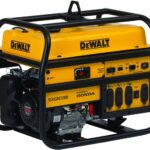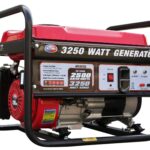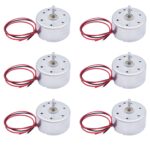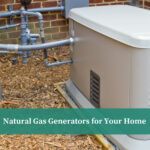Are you looking for a way to power your home when the electricity goes out? If so, then running your house on a generator might be the ideal solution. This step-by-step guide will show you how to run your house on a generator and help you understand the basics of generator technology. With this guide, you’ll be able to get the most out of your generator and make sure your home is always powered, no matter what.
Types of Generators

- Portable Generators
- Standby Generators
- Inverter Generators
Portable generators are small and lightweight, and are ideal for providing temporary power to your home in an emergency or for powering tools and appliances outdoors. Standby generators are larger, more powerful units that are permanently installed outside your home. They can be connected to your home’s electrical system to provide power for all your household needs. Inverter generators are designed to produce clean electricity for powering sensitive electronic devices such as computers and tablets.
Portable Generators


Portable generators are a convenient and cost-effective way to power your home in an emergency. They are lightweight, easy to move and can be used in a variety of situations.
| Type | Advantages | Disadvantages |
|---|---|---|
| Gasoline Generator | Easy to use, widely available, affordable. | Noisy and require regular maintenance. |
| Diesel Generator | Durable and more fuel efficient than gasoline generators. | More expensive than gasoline generators. |
| Propane Generator | Quieter than gasoline and diesel generators and more efficient. | Expensive, requires tanks or refillable propane cylinders. |
Portable generators can be powered by gasoline, diesel or propane, and come in a variety of sizes to suit any need. When choosing a generator, consider the size of your home and the appliances you need to power. Generators that are too small or too large can be inefficient and difficult to manage. It’s also important to consider noise levels, safety features, and maintenance requirements.
When using a portable generator, be sure to follow all safety guidelines. Generators should be used outdoors in well-ventilated areas and never in enclosed spaces. Gasoline and diesel generators should be kept at least 15 feet away from your home, and propane generators should be kept at least 10 feet away. Also, be sure to always use a transfer switch to ensure the generator is properly isolated from the power grid.
Standby Generators


- Standby generators run on natural gas, propane, or diesel fuel.
- These types of generators are typically installed outdoors and connected to your home’s main power supply.
- They automatically kick in whenever the power goes out, providing more reliable backup power.
- Standby generators can power the entire house, or just a few key appliances.
- They are typically more expensive than portable generators, but can provide more power.
Considerations Before Purchasing a Generator

| Priority | Consideration |
|---|---|
| 1 | Purpose: Determine the purpose of the generator. Will the generator be used as a backup source of power or as the main source of power? |
| 2 | Size: Calculate the wattage and amperage of your home’s electrical systems, such as the air conditioner, refrigerator, and other appliances. This will help you determine the size of the generator needed. |
| 3 | Fuel Type: Consider the type of fuel the generator uses. Some generators run on gasoline, diesel, propane, or natural gas. |
| 4 | Cost: Consider the cost of the generator, as well as the cost of fuel and maintenance. |
| 5 | Portability: Consider if the generator needs to be portable, or if a stationary generator will suffice. |
| 6 | Noise Level: Consider the noise level of the generator. Generators can be noisy, so it is important to choose one that is not too loud for your area. |
When purchasing a generator, it is important to consider the purpose, size, fuel type, cost, portability, and noise level of the generator. By taking these factors into account, you can ensure that you select the right generator for your needs.
Calculating The Necessary Power Output

Before purchasing a generator for running a house, it is important to calculate the necessary power output to make sure the generator can handle the load. This is done by adding up the total wattage of all the appliances, motors and electronic items that will be running at the same time.
The wattage of the appliances can be found on the labels of the appliances. Calculate the wattage of the motors and electronic items by multiplying the voltage by the amperes. Once the total wattage of all the appliances, motors and electronic items is known, it should be multiplied by 1.5 to determine the starting wattage of the generator.
For example, if all the appliances, motors and electronic items total 7,000 watts, then the starting wattage of the generator should be at least 10,500 watts. This number can then be used to select the appropriate generator for the house.
Safety Precautions

- Keep the generator in a well-ventilated area.
- Do not use a generator indoors, in a basement, or in any enclosed or partially enclosed space.
- Install carbon monoxide detectors near sleeping areas.
- Keep the generator away from windows, doors, and vents.
- Be sure to use the correct fuel for your generator.
- Check and follow all instructions in the owner’s manual and on the generator.
- Check the generator regularly for loose wires, frayed cords, or any other signs of danger.
- Be sure to turn off the generator and let it cool down before refueling.
- Never add fuel while the engine is running.
- Keep children away from the generator at all times.
- Make sure the generator is not overloaded.
- Always plug appliances directly into the generator.
- Be sure to turn off the generator before disconnecting any appliance.
Installation of Generators

| Steps | Instructions |
|---|---|
| 1 | Choose a location for the generator: Select a well-ventilated location, away from doors, windows, and vents. |
| 2 | Connect the generator to a fuel source: Connect the generator to a fuel source such as propane, natural gas, or gasoline. |
| 3 | Install the generator: Install the generator according to the manufacturer’s instructions. |
| 4 | Position the generator: Place the generator in the chosen location and secure it to prevent it from moving. |
| 5 | Connect the generator to an electrical source: Connect the generator to an electrical source using heavy-duty extension cords. |
| 6 | Connect the generator to the house wiring: Connect the generator to the house wiring using an approved transfer switch. |
| 7 | Test the generator: Test the generator to ensure that it is working properly. |
Portable Generators


A portable generator is the most common type of generator used for home backup power. It is a self-contained unit with an engine, alternator, fuel tank, and other components that can be moved from one location to another. Portable generators come in a variety of sizes, from small models that can be used to power a few appliances to large units that can provide enough electricity to run an entire house.
| Generator Type | Power Output |
|---|---|
| Small Portable | 1,000-3,500 watts |
| Medium Portable | 3,500-7,000 watts |
| Large Portable | 7,000-10,000 watts |
Portable generators are ideal for home use because of their portability and relatively low cost. However, they are not as powerful as other types of home backup generators and tend to require more maintenance and fuel. Additionally, portable generators must be used outdoors to avoid the risk of carbon monoxide poisoning.
Standby Generators


- Standby generators are a great way to ensure your home’s power supply is backed up in case of a power outage.
- Standby generators are permanently installed and connected to your home’s natural gas or propane line.
- They kick in automatically when power is lost and provide enough juice to power essential appliances like refrigerators, heaters, and lights.
- Standby generators are more expensive than portable generators, but they require less maintenance and provide a more reliable power source.
- When selecting a standby generator for your home, consider the size of your home and the wattage requirements of the devices you will be powering.
Connecting Appliances and Electrical Systems to Generator

The first step in running a house on a generator is to connect appliances and electrical systems to the generator. This should be done in a safe and responsible manner. Generators should be connected to the home’s electrical system by a professional electrician, who can ensure that the connection is done safely and correctly. This can be done by wiring the generator directly to the home’s main electrical panel, or by installing a transfer switch. Transfer switches are designed to allow the electrical system to switch between the utility power and the generator power automatically.
Once the connection to the home’s electrical system is complete, the next step is to connect the appliances to the generator. Depending on the type of generator, this can be done in several ways. For small generators, it is possible to simply plug the appliance into the generator’s outlet. For larger generators, it is necessary to use an extension cord to make the connection. When using extension cords, it is important to make sure that the cord is rated for the appliance that is being connected.
Once the appliances are connected, the generator can be turned on. It is important to remember to turn off the generator before connecting or disconnecting any appliances. This will help to ensure the safety of the people in the home, as well as the longevity of the generator.
Electrical Wiring

- Turn off the main switch in the utility box.
- Connect the generator to the main power line.
- Connect the generator to the utility box.
- Connect the transfer switch to the generator.
- Wire the transfer switch to the utility box.
- Connect the generator to the appliances.
- Check all connections and make sure they are secure.
Extension Cords

Extension cords are essential for running a generator in your home. They are necessary to connect the generator to the appliances you want to power in your home. When selecting extension cords, make sure that the cords have enough wattage to power all of the items you want to connect. The wattage rating of the cord should be higher than the wattage of the appliance to be powered. Additionally, the cord should be of the appropriate length and gauge. The length should be long enough to reach the appliance and the gauge should be sufficient to carry the wattage without overheating.
| Length | Gauge | Wattage |
|---|---|---|
| 100 ft | 12 | 1800W |
| 50 ft | 10 | 2700W |
| 25 ft | 8 | 3600W |
When selecting an extension cord, it is important to make sure the wattage rating is higher than the wattage of the appliance you want to power. As a general rule, a 12 gauge extension cord should be used for appliances up to 1800W, a 10 gauge cord for up to 2700W, and an 8 gauge cord for up to 3600W. Higher wattage appliances will require larger gauges. Additionally, the length of the cord should be sufficient to reach the appliance.
Operating a Generator

- Read the generator’s instruction manual before starting.
- Check oil and fuel levels before turning on the generator.
- Turn off all appliances connected to the generator.
- Slide the switch to the “On” position.
- Allow the generator to run for a few minutes before turning on connected appliances.
- Turn on the appliances one-by-one, starting with the most power intensive.
- Monitor the generator’s performance and fuel levels.
Filling the Tank

- Turn off the generator and ensure all switches are in off position.
- Prop open the fuel tank cap and fill the tank with fresh fuel.
- Close the tank cap and turn on the generator.
- Check the fuel gauge to ensure the tank is full.
Starting the Generator

Before starting the generator, it is important to check the fuel level and oil level. If the fuel level is low, it should be refilled with the specified fuel type. If the oil level is low, it should be refilled with the recommended engine oil. Once the fuel and oil levels are checked, the generator can be started.
To start the generator, locate the starter switch or button. This can usually be found on the side of the generator. Push the starter switch or button to start the generator. This will cause the generator to begin to hum and the lights to turn on.
Once the generator is running, check the operation of the generator by turning on the lights, appliances, and other equipment. Make sure to monitor the generator while it is running and shut it off immediately if any problems arise.
When finished, turn off the generator and wait for the generator to cool down before turning it off. Make sure to shut all of the appliances that were running and unplug them from the generator. Once the generator has cooled down, it is safe to store.
Shutting Down the Generator
Before shutting down the generator, it is important to turn off all appliances, lights, and other devices that may be connected to the generator. Ensure that all loads are disconnected from the generator and that any switchboards or breaker panels are in the off position. Once all loads are disconnected from the generator, it is safe to shut down the generator.
To shut down the generator, turn the engine switch to the “off” position, which should be located on the generator. If the generator has an automatic shut-off feature, turn the switch to the “auto” position and the generator will shut down automatically.
Once the generator is shut down, it is important to turn off the fuel supply to the generator. This can be done by turning the fuel valve to the “off” position. It is also important to ensure that the generator is cool before attempting to service or store it.
Finally, it is important to perform routine maintenance and inspections on the generator as recommended by the manufacturer. This will help ensure that the generator is operating in peak condition and will extend the life of the generator.
Maintenance of Generators
- Check and change oil and oil filter regularly
- Check and clean air filter regularly
- Check and clean spark plug regularly
- Check and clean fuel filter regularly
- Check and clean exhaust system regularly
- Check and clean cooling system regularly
- Check and clean generator housing regularly
- Check and replace batteries regularly
- Check and tighten all electrical connections regularly
- Check for any leakage or damage to the fuel line regularly
Frequently Asked Questions
How do I set up a generator to power my home?
To set up a generator to power your home, you will need to install a transfer switch. This switch will allow you to turn off power from the utility company and switch it over to your generator. You will also need to ensure there is enough fuel to keep the generator running. Install the generator near an outdoor power outlet and connect the generator to the transfer switch. Make sure all of your breakers in the switch are in the off position before you start the generator. Once the generator is running, you can switch the breakers to the “on” position one at a time to power up your home. Finally, you will need to monitor the fuel levels of your generator and refill as necessary to ensure it can provide power for your home.
Is it possible to use a Portable Generator to Power My House?
Yes, it is possible to use a portable generator to power a house. Portable generators are often used as an emergency backup power source when the main power supply is disrupted. To run a house on a generator, the generator must be properly sized and wired to the house’s circuit breaker panel. The generator must be able to provide sufficient power to run all the appliances in the house, including the air conditioner and other large appliances. If a generator is not properly sized, it could be overloaded, leading to potential safety hazards such as fire or electric shock. It is also important to remember to turn off the main power supply when connecting the generator to the house.
What are the Safety Considerations when Running a House on a Generator?
When running a house on a generator, it is important to consider safety measures to avoid fire, electrocution, and carbon monoxide poisoning. Proper installation and maintenance of the generator is necessary to ensure it is working safely. Make sure the generator is kept in a dry, ventilated area away from windows, vents, and doors to avoid carbon monoxide poisoning. Additionally, the generator should be securely grounded to avoid electrocution and an overload protection should be installed to protect against overloads. Before connecting the generator to the home’s main power lines, make sure to turn off the main circuit breaker in the house and unplug all appliances from the wall outlets. Lastly, a generator should never be left unattended and it should be turned off and cooled down for at least two minutes before refueling.
What Size Generator Do I Need to Power My Home?
The size of the generator needed to power a home is determined by the wattage needed to run all of the appliances and electronics. To calculate the wattage needed, total the wattage of each appliance and then add 20-30% extra to cover any potential surge in wattage. Common items such as refrigerators, air conditioners, and water heaters require more wattage than items such as gaming consoles, TVs, and computers. Make sure the generator has a transfer switch in order to prevent any backfeed of electricity into the power lines.
Are there any special considerations for connecting a generator to my home’s electrical system?
When connecting a generator to your home’s electrical system, it is important to ensure the generator is properly grounded and that the connection is done according to local building codes and manufacturer’s instructions. In addition, it is recommended that all utility power be disconnected when connecting a generator to the home’s electrical system to prevent back-feeding which can be dangerous. Finally, it is important to always use a transfer switch to connect the generator to the home’s electrical system.
Conclusion
Running a house on a generator is a great way to keep power running in the event of a power outage. With the right generator and fuel, as well as a few safety precautions, it’s easy to get up and running quickly and keep your home powered during an emergency. Once everything is set up, running your house on a generator is relatively simple and can save you a lot of stress in the event of a power failure.







